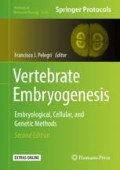Abstract
The earliest steps of animal development depend upon posttranscriptional events that drive the embryonic cell cycle and guide cell fate decisions. The analysis of post-transcriptional regulatory events has relied upon the use of chimeric reporter mRNAs that encode firefly luciferase fused to potential regulatory sequences. A new and more sensitive luciferase developed recently called NanoLuc has the potential to improve reporter studies and provide new insights into the regulation of embryonic processes. Here I describe how to create and analyze reporter mRNAs encoding NanoLuc luciferase using extracts from microinjected Xenopus embryos.
Access this chapter
Tax calculation will be finalised at checkout
Purchases are for personal use only
References
Sheets MD, Fox CA, Hunt T, Vande Woude G, Wickens M (1994) The 3′-untranslated regions of c-mos and cyclin mRNAs stimulate translation by regulating cytoplasmic polyadenylation. Genes Dev 8:926–938
Arnone MI, Dmochowski IJ, Gache C (2004) Using reporter genes to study cis-regulatory elements. Methods Cell Biol 74:621–652
Miraglia LJ, King FJ, Damoiseaux R (2011) Seeing the light: luminescent reporter gene assays. Comb Chem High Throughput Screen 14:648–657
Gallie DR (1991) The cap and poly(A) tail function synergistically to regulate mRNA translational efficiency. Genes Dev 5:2108–2116
Rizzo MA, Davidson MW, Piston DW (2009) Fluorescent protein tracking and detection: applications using fluorescent proteins in living cells. Cold Spring Harb Protoc 2009:pdb top64
Giepmans BN, Adams SR, Ellisman MH, Tsien RY (2006) The fluorescent toolbox for assessing protein location and function. Science 312:217–224
de Wet JR, Wood KV, Helinski DR, DeLuca M (1985) Cloning of firefly luciferase cDNA and the expression of active luciferase in Escherichia coli. Proc Natl Acad Sci U S A 82:7870–7873
Hooper CE, Ansorge RE, Rushbrooke JG (1994) Low-light imaging technology in the life sciences. J Biolumin Chemilumin 9:113–122
Hall MP, Unch J, Binkowski BF, Valley MP, Braeden LB, Wood MG et al (2012) Engineered luciferase reporter from a deep sea shrimp utilizing a novel imidazopyrazinone substrate. ACS Chem Biol 7:1848–1857
England CG, Ehlerding EB, Cai W (2016) NanoLuc: a small luciferase is brightening up the field of bioluminescence. Bioconjug Chem 27:1175–1187
Nilsen TW, Rio DC (2012) In vitro transcription of labeled RNA: synthesis, capping, and substitution. Cold Spring Harb Protoc 2012:1181–1186
Rio DC (2015) Denaturation and electrophoresis of RNA with glyoxal. Cold Spring Harb Protoc 2015:223–226
Rio DC (2015) Denaturation and electrophoresis of RNA with formaldehyde. Cold Spring Harb Protoc 2015:219–222
Park S, Blaser S, Marchal MA, Houston DW, Sheets MD (2016) A gradient of maternal Bicaudal-C controls vertebrate embryogenesis via translational repression of mRNAs encoding cell fate regulators. Development 143:864–871
Zhang Y, Cooke A, Park s, Dewey CN, Wickens M, Sheets MD (2013) Bicaudal-C spatially controls translation of vertebrate maternal mRNAs. RNA 19:1575–1582
Zhang Y, Forinash KD, McGivern J, Fritz B, Dorey K, Sheets MD (2009) Spatially restricted translation of the xCR1 mRNA in Xenopus embryos. Mol Cell Biol 29:3791–3802
Sive HL, Grainger RM, Harland RM (2010) Microinjection of Xenopus embryos. Cold Spring Harb Protoc 2010:pdb ip81
Acknowledgments
Work in the Sheets lab was supported by NIH grants (R21HD076828, R01HD091921).
Author information
Authors and Affiliations
Corresponding author
Editor information
Editors and Affiliations
Rights and permissions
Copyright information
© 2019 Springer Science+Business Media, LLC, part of Springer Nature
About this protocol
Cite this protocol
Sheets, M.D. (2019). Assaying NanoLuc Luciferase Activity from mRNA-Injected Xenopus Embryos. In: Pelegri, F. (eds) Vertebrate Embryogenesis. Methods in Molecular Biology, vol 1920. Humana, New York, NY. https://doi.org/10.1007/978-1-4939-9009-2_3
Download citation
DOI: https://doi.org/10.1007/978-1-4939-9009-2_3
Published:
Publisher Name: Humana, New York, NY
Print ISBN: 978-1-4939-9008-5
Online ISBN: 978-1-4939-9009-2
eBook Packages: Springer Protocols

